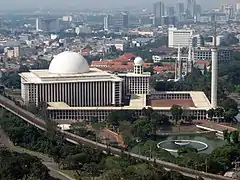Sultanate of Tidore
Sultanate of Tidore (Indonesian: Kesultanan Tidore, sometimes Kerajaan Tidore) was a sultanate in Southeast Asia, centered on Tidore in the Spice Islands (presently in North Maluku Province). It was also known as Duko, its ruler carrying the title Kië ma-kolano (Ruler of the Mountain). Tidore was a rival of the Sultanate of Ternate for control of the spice trade, and had an important historical role as binding the archipelagic civilizations of Indonesia to the Papuan world.[1]
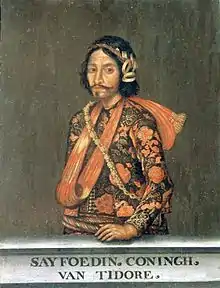
Sultanate of Tidore Kesultanan Tidore | |||||||
|---|---|---|---|---|---|---|---|
| 1450–1967 | |||||||
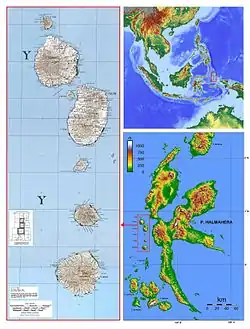 | |||||||
| Capital | Tidore | ||||||
| Common languages | Tidore | ||||||
| Religion | Sunni Islam | ||||||
| Government | Sultanate | ||||||
| Sultan | |||||||
| History | |||||||
• Established | 1450 | ||||||
• Disestablished | 1967 | ||||||
| |||||||
| Today part of | |||||||
Origins
According to later historical traditions, the four kingdoms of North Maluku, Ternate, Tidore, Bacan, and Jailolo, had a common root. A story that arose after the introduction of Islam says that the common ancestor was an Arab, Jafar Sadik, who married a heavenly nymph (bidadari) and sired four sons, of whom Sahjati became the first kolano (ruler) of Tidore.[2] The term kolano might be a Javanese loanword, pointing at early cultural influences from Java.[3] The first eight kolanos are proto-historical as there are no contemporary sources on Tidore until the early 16th century.[4] The ninth, Ciri Leliatu, was reportedly converted to Islam by an Arab, Syekh Mansur, and named his oldest son after the preacher.[5] According to European sources, Islam was accepted by the North Malukan elite in about the 1460s-1470s. Ciri Leliatu's son Sultan al-Mansur ruled when the Portuguese first visited Maluku in 1512, and met the remnants of the Magellan expedition in 1521-22.[6] By that time the sultanate lived in an uneasy and ambiguous relation with its close neighbour Ternate. Though frequently at war, Tidore had a ritual precedence position since his daughters regularly married Ternatan sultans and princes.[7]
Geographical extent
Together, the two sultanates Ternate and Tidore exercised suzerainty over a huge area from Sulawesi to West Papua. Supposedly, the first Tidore sultan Ciri Leliatu invaded the Papuan island Gebe, a local power center, in the late 15th century and thereby gained access to valuable forest products of the Raja Ampat Islands and New Guinea. Some sources date the start of Tidore influence in these quarters to his son al-Mansur, who bonded a chief from Waigeo, Gurabesi, and created bonds with Papuan villages with his assistance.[8] However, the Papuan dependencies are only documented in the 17th century. Tidore furthermore ruled over parts of Halmahera and islands close by, especially the Gamrange area in the south-east (Maba, Weda and Patani). At times, Tidore controlled East Seram, and laid claims to outlying places such as Buru and Aru.[9]
Administration
The base of Tidoren society was the soa, socio-political units headed by bobato (headmen). A bobato was a state official but also a guardian of the interests of his community. On the basic level in the outlying areas (Halmahera, etc.) were various kimelaha (local leaders formally appointed by the sultan), who in turn stood under sangaji (honoured princes) who lorded as vassals over various territories belonging to the sultanate. At the center was a state council consisting of 31 members including the 27 bobato, two hukum (magistrates), one kapiten laut (sea lord), and a jojau (chief minister). Moreover, the sultan employed utusan or envoys who visited the various outer areas under Tidore's sway and collected tributes.[10]
Alliance with Spain
Tidore established a loose alliance with the Spanish in the sixteenth century, starting with the visit of the Magellan expedition in 1521-22. The aim was to counter the power of Ternate, which had allied with the Portuguese since 1512. At the start, this did not mean much due to rare Spanish visits, and Tidore suffered a series of serious defeats in 1524, 1526, 1529, 1536 and 1560. However, the Ternatan sultan Babullah broke with the Portuguese in 1570 and greatly expanded his territory in all directions. Feeling slighted, the Tidorese under Gapi Baguna allied with the Portuguese and allowed them to build a fort on their island in 1578.[11] After the merger of Portugal and Spain in 1581, Spain, already established in the Philippines, took over the Iberian initiative and kept several forts on the island. There was also a limited presence of Catholic missionaries in Tidore, who managed to convert a few members of the elite.[12] While there was much mutual distrust between the Tidorese and the Spaniards, for Tidore the Spanish presence was helpful in resisting incursions by their Ternatan enemy. Nevertheless, it lost vital territories in Halmahera by the end of the 16th century, which had supplied Tidore Island with sago, a vital stock food.[13]
Arrival of the VOC
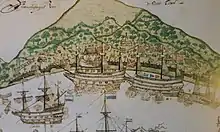
The Spaniards launched a major attack on Ternate from their Philippines base in 1606. This was successful, the power of Ternate was curbed, and Tidore was allowed to take over certain Ternatan dependencies. This alerted the Dutch of the United East India Company (VOC), who had just taken over Ambon and strove to control the lucrative trade in spices. Spain and the Dutch Republic were at war in Europe, and their rivalry had global implications. The VOC allied with the new Ternatan sultan and launched their own expedition in 1607.[14] As a result Ternate became heavily dependent on the Dutch, who also made incursions in Tidore over the next years and secured some coastal forts. Sultan Mole Majimu of Tidore held on to his allegiance to Spain, although some Tidorese princes leaned towards Ternate and the VOC. By this time the royal clan had split into two rivalling lineages which made for rapid throne shifts. The Spanish authorities found the sultans to be a nuisance rather than a help to the Spanish power.[15]
A relatively pro-VOC sultan, Saifuddin, came to the throne in 1657 by pushing the other royal lineage aside. He agreed with the Dutch to eradicate all clove trees in his realm, in line with the VOC monopoly policy on the spice trade. In return he received a yearly compensation.[16] The Spanish in the Philippines, who needed all available resources for their defense against the Sino-Japanese pirate lord Koxinga, decided to withdraw from Tidore in 1662. This was effectuated in 1663-66.[17] In the 17th century Tidore became one of the most independent kingdoms in the region, resisting direct control by Dutch East India Company (VOC). Particularly under Sultan Saifuddin's rule (1657–1687), the Tidore court was skilled at using Dutch payment for spices for gifts to strengthen traditional ties with Tidore's traditional periphery. As a result, he was widely respected by many local populations, and had little need to call on the Dutch for military help in governing the kingdom, as Ternate frequently did.[18]
Rebellion and colonial penetration
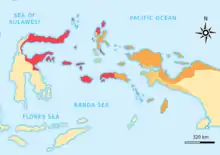
Tidore remained an independent kingdom, albeit with frequent Dutch interference, until the late eighteenth century. Like Ternate, Tidore allowed the Dutch spice eradication program (extirpatie) to proceed in its territories. This program, intended to strengthen the Dutch spice monopoly by limiting production to a few places, impoverished Tidore as well as its Ternate neighbour and weakened its control over its periphery. A treaty in 1768 forced Sultan Jamaluddin to cede his rights to East Seram which had been granted Tidore in 1700, which created great anger among the elite. The unrest caused the VOC authorities to depose Jamaluddin in 1779 and to force his successor Patra Alam to conclude a new contract that abrogated the old one from 1667. With this document (1780), Tidore was turned from an ally to a vassal and thus lost its independence.[19] One of the exiled Jamaluddin's sons, Nuku, reacted on this by starting a rebellion in 1780, seeking support in the marginal areas of the Tidore realm. The uprising took on violently anti-Dutch features where Islam was an important ideological glue. Nuku in particular found allies in Halmahera, Seram and the Raja Ampat Islands, but also in places that had not been subservient to Tidore, such as the Kei and Aru Islands. After several shifts Nuku allied with the British, who were at war with the Dutch after 1795 and were in the process of conquering Dutch colonial possessions. In 1797 he captured Bacan and then Tidore itself, expelling the VOC-backed Sultan Kamaluddin. Nuku was enthroned as Sultan Muhammad al-Mabus Amiruddin. As such he took care to restore the defunct Jailolo sultanate in order to return to the traditional, pre-European quadripartition of Maluku.[20] In 1801 Ternate was captured by the British and Tidorese after a long siege. However the Peace of Amiens in Europe changed the strategical positions in the next year already, since the Dutch were allowed to retake their positions in Maluku. After the death of Nuku in 1805, his brother, Sultan Zainal Abidin, proved unable to resist the Dutch-Ternatan attacks. Tidore was lost in 1806 and the sultan fled, finally dying in exile in 1810.[21]
Tidore was subjected to an increasing implementation of colonial rule in the 19th century. A treaty was signed in 1817 were the sultan and grandees received annual subsidies. Tidore was included in the Residency of Ternate together with Ternate, Bacan, Halmahera and dependencies. The infamous hongi expeditions which had ensured the eradication of unpermitted spice trees in Maluku were finally abolished in 1861.[22] The sultan title lapsed in 1905, and was replaced by a regency. It was only after the outbreak of the Indonesian revolution that the Dutch authorities allowed a new sultan to be enthroned, Zainal Abidin Alting (r. 1947-1967). After the gaining of Indonesian independence in 1949, old monarchical institutions were abolished by and by. However, the historical status of the sultan played a certain role to bolster Indonesian claims to Dutch New Guinea. Thus Zainal Abidin was appointed Governor of Irian Barat (Papua) during the years 1956-61, at a time when the region was still under Dutch control. After his governorship, he settled in Ambon where he died in 1967.[23] No new sultan was appointed. However, with the increasing interest in Indonesia for local tradition after the end of the Suharto era, some aspects of the sultanate were taken up. Titular sultans have been chosen from among the different royal branches since 1999.
List of Sultans
| Kolanos and Sultans of Tidore | Reign |
|---|---|
| Sahjati[lower-alpha 1] | |
| Busamuangi | |
| Suhu | |
| Balibungah | |
| Duku Madoya | |
| Kie Matiti | |
| Sele | |
| Matagena | |
| Ciri Leliatu (Jamaluddin) | late 15th/early 16th century |
| Al-Mansur | before 1512-1526 |
| Mir (Amiruddin Iskandar Dulkarna'in) | 1526-1550s |
| Gava[lower-alpha 2] | 1550s-1560 |
| Gapi Baguna | 1560-1599 |
| Mole Majimu | 1599-1627 |
| Ngarolamo | 1627-1634 |
| Gorontalo | 1634-1639 |
| Saidi | 1640-1657 |
| Saifuddin | 1657-1687 |
| Hamza Faharuddin | 1689-1705 |
| Abu Falalal Mansur | 1705-1708 |
| Hasanuddin | 1708-1728 |
| Malikulmanan | 1728-1757 |
| Jamaluddin | 1757-1779 |
| Gayjira (regent) | 1779-1780 |
| Patra Alam | 1780-1783 |
| Kamaluddin | 1783-1797 |
| Nuku, Muhammad al-Mabus Amiruddin | 1797-1805 |
| Zainal Abidin | 1805-1810 |
| Muhammad Tahir | 1811-1821 |
| Al-Mansur Sirajuddin | 1822-1856 |
| Ahmad Saifuddin Alting | 1856-1865 |
| Ahmad Fathuddin | 1867-1892 |
| Iskandar Sahajuhan | 1893-1905 |
| Zainal Abidin Alting | 1947-1967 |
| Haji Djafar Dano Junus | 1999-2012 |
| Husain Syah | 2012- |
Notes
- François Valentijn (1724) mentions two early Tidorese Muslim kings, Nuruddin (c. 1343) and Hasan Syah (c. 1372), not known to the local king lists; see F.S.A. de Clercq (1890) Bijdragen tot de kennis der Residentie Ternate. Leiden: Brill, p. 148 .
- Tidore king list have Kië Mansur and Iskandar Sani as sultans between Mir and Gapi Baguna, though these names are not found in the contemporary sources; see F.S.A. de Clercq (1890) Bijdragen tot de kennis der Residentie Ternate. Leiden: Brill, p. 321 .
References
- C.F. van Fraassen (1987), Ternate, de Molukken en de Indonesische Archipel. Leiden: Rijksmuseum te Leiden, Vol. I, p. 16-8.
- Leonard Andaya (1993), The world of Maluku. Honolulu: University of Hawai'i Press, p. 59.
- F.S.A. de Clercq (1890) Bijdragen tot de kennis der Residentie Ternate. Leiden: Brill, p. 321
- P.J.B.C. Robidé van der Aa (1879) Reizen naar Nederlandsch Nieuw-Guinea. 's-Gravenhage: M. Nijhoff, p. 18-19
- Willard A. Hanna & Des Alwi (1990), Turbulent times past in Ternate and Tidore. Banda Naira: Rumah Budaya Banda Naira, p. 20-5.
- Extensive genealogical explanation in C.F. van Fraassen (1987), Vol. II, p. 13-30.
- Leonard Andaya (1993), p. 105.
- Muridan Widjojo (2009), The revolt of Prince Nuku: Cross-cultural alliance-making in Maluku, c. 1780-1810. Leiden: Brill, p. 52-3; Hans Hägerdal & Emilie Wellfelt (2019), "Tamalola: Transregional connectivities, Islam, and anti-colonialism on an Indonesian island", Wacana, No. 20-3.
- Muridan Widjojo (2009), p. 47-9.
- Leonard Andaya (1993), p. 133.
- Hubert Jacobs (1980), Documenta Molucensia, Vol. II. Rome: Jesuit Historical Institute.
- Leonard Anadaya (1993), p. 169-70.
- Margaret Makepeace, ‘Middleton, Sir Henry (d. 1613)’, Oxford Dictionary of National Biography, Oxford University Press, 2004; online edn, Jan 2008
- Hubert Jacobs (1984), Documenta Molucensia, Vol. III. Rome: Jesuit Historical Institute, p. 6.
- Leonard Andaya (1993), p. 171.
- Leonard Andaya (1993), p. 155-6.
- Leonard Andaya (1993), p. 170-4.
- Muridan Widjojo (2009), p. 52-6.
- Leonard Andaya (1993), p. 235-6.
- Muridan Widjojo (2009), p. 88-93.
- F.S.A. de Clercq (1890), p. 171-82.
- Menggali sejarah Papua dari Tidore
